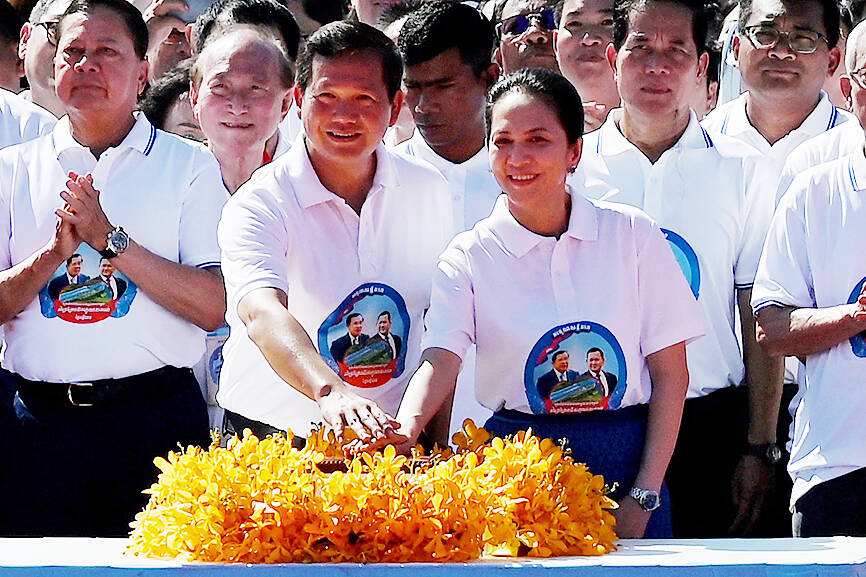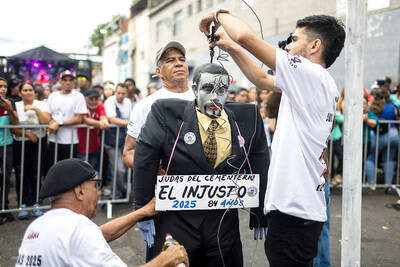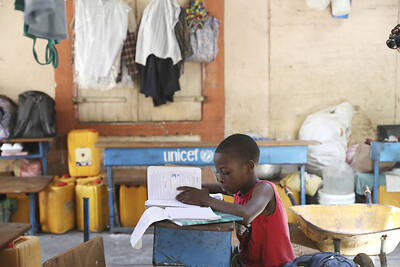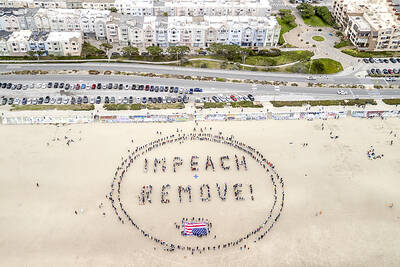Cambodian Prime Minister Hun Manet yesterday launched a controversial US$1.7 billion canal project that aims to provide a new link from the Mekong River to the sea.
At a launch event in Prek Takeo, southeast of the capital, Phnom Penh, Hun Manet called the 180km project “historic,” as drums sounded and fireworks shot into the air.
The event was attended by thousands wearing T-shirts bearing images of Hun Manet and his father, Hun Sen, who ruled the nation for nearly four decades.

Photo: AFP
“We must build this canal at all costs,” said Hun Manet, who drew cheers as he launched the project by pressing a ceremonial button with his wife, Pich Chanmony.
The Funan Techo Canal is to run from a spot on the Mekong, about an hour’s drive southeast of Phnom Penh, to the sea in the Gulf of Thailand and is due to be completed in 2028.
About one-third of cargo coming to and from Cambodia uses Vietnamese ports via the Mekong, but authorities hope that number would fall to about 10 percent once the canal is completed.
The limited capacity of the waterway — 100m wide and 5.4m deep — has raised questions about whether the lofty economic goals can be reached.
The project also comes shrouded in uncertainty, including its main purpose — whether for shipping or irrigation — who would fund it and how it would affect the flow of the Mekong — one of the world’s longest rivers.
Conservationists have long warned that the river, which supports up to one-quarter of the world’s freshwater fish catch and half of Vietnam’s rice production, is at risk from infrastructure projects, pollution, sand mining and climate change.
Cambodia, Laos, Vietnam and Thailand are signatories to the 1995 Mekong River Agreement, which governs the distribution of the river’s resources.
Cambodia has notified the Mekong River Commission of its plans for the canal, but Vietnam wants more information about the project.
Phnom Penh argues that the project affects only a Mekong tributary and therefore requires only the notification it has already submitted.
The canal, one of former Cambodian prime minister Hun Sen’s signature infrastructure projects, is seen as a galvanizing national undertaking to build support for his successor and son.
Hun Sen has described the canal as giving the nation a “nose to breathe through.”
The Cambodian government says the project would offer an alternative for container ships that currently cross into Vietnam before heading to the sea, allowing Cambodia to keep transport revenue in-country.
It says it is planning riverside economic zones along the route that it says could create tens of thousands of jobs for the nation, which is among the poorest in Southeast Asia.
However, villagers living along the projected route of the canal spoke about their anguish at having their homes expropriated as construction gets under way.
Some, who live near the canal, said they were not invited to join the event, saying they watched the ceremony from home with mixed feelings.
“We feel both happy and worried because we have not been informed about the compensation,” said a 51-year-old woman, who asked not to be named. “We are asking for an appropriate compensation. People told us that when there are developments, there are tears. So we are worried about that.”
Cambodian Deputy Prime Minister Sun Chanthol, who spearheaded the project, said at the event that the canal would benefit 1.6 million people and create “thousands of jobs.”
He promised that the government would provide “fair compensation” to those affected by the project.
Rights activists point to a pattern of expropriation for infrastructure projects that has left people struggling to relocate with minimal compensation.
Last year, China Road and Bridge Corp (CRBC), a Chinese construction giant that has financed other infrastructure in Cambodia, agreed to a feasibility study of the project.
Cambodian officials have suggested the Chinese state-owned company could finance part of the canal, but CRBC has not released its study or made any public commitment.
While Cambodia is a close ally of Beijing, Hun Sen has denied the canal would be part of China’s Belt and Road Initiative.
The project has sparked fears in neighboring Vietnam that the canal could be used by Chinese warships.
Cambodia and China held their largest annual military exercises in May, involving several Chinese military vessels and hundreds of military personnel.
In December last year, two Chinese warships made a first visit to a Cambodian naval base that the US says could be used to boost China’s influence in the Gulf of Thailand.
Cambodian officials have repeatedly denied that the base, near the port city of Sihanoukville, is for use by any foreign power.

POLITICAL PRISONERS VS DEPORTEES: Venezuela’s prosecutor’s office slammed the call by El Salvador’s leader, accusing him of crimes against humanity Salvadoran President Nayib Bukele on Sunday proposed carrying out a prisoner swap with Venezuela, suggesting he would exchange Venezuelan deportees from the US his government has kept imprisoned for what he called “political prisoners” in Venezuela. In a post on X, directed at Venezuelan President Nicolas Maduro, Bukele listed off a number of family members of high-level opposition figures in Venezuela, journalists and activists detained during the South American government’s electoral crackdown last year. “The only reason they are imprisoned is for having opposed you and your electoral fraud,” he wrote to Maduro. “However, I want to propose a humanitarian agreement that

Young women standing idly around a park in Tokyo’s west suggest that a giant statue of Godzilla is not the only attraction for a record number of foreign tourists. Their faces lit by the cold glow of their phones, the women lining Okubo Park are evidence that sex tourism has developed as a dark flipside to the bustling Kabukicho nightlife district. Increasing numbers of foreign men are flocking to the area after seeing videos on social media. One of the women said that the area near Kabukicho, where Godzilla rumbles and belches smoke atop a cinema, has become a “real

‘POINT OF NO RETURN’: The Caribbean nation needs increased international funding and support for a multinational force to help police tackle expanding gang violence The top UN official in Haiti on Monday sounded an alarm to the UN Security Council that escalating gang violence is liable to lead the Caribbean nation to “a point of no return.” Special Representative of the UN Secretary-General for Haiti Maria Isabel Salvador said that “Haiti could face total chaos” without increased funding and support for the operation of the Kenya-led multinational force helping Haiti’s police to tackle the gangs’ expanding violence into areas beyond the capital, Port-Au-Prince. Most recently, gangs seized the city of Mirebalais in central Haiti, and during the attack more than 500 prisoners were freed, she said.

DEMONSTRATIONS: A protester said although she would normally sit back and wait for the next election, she cannot do it this time, adding that ‘we’ve lost too much already’ Thousands of protesters rallied on Saturday in New York, Washington and other cities across the US for a second major round of demonstrations against US President Donald Trump and his hard-line policies. In New York, people gathered outside the city’s main library carrying signs targeting the US president with slogans such as: “No Kings in America” and “Resist Tyranny.” Many took aim at Trump’s deportations of undocumented migrants, chanting: “No ICE [Immigration and Customs Enforcement], no fear, immigrants are welcome here.” In Washington, protesters voiced concern that Trump was threatening long-respected constitutional norms, including the right to due process. The